After a milder winter season and some rain, ice on central Wisconsin's lakes might be weaker than normal.
"As the season progresses here the sun gets more intense and conditions deteriorate quite rapidly," said Bryan Lockman, DNR Warden, "So the ice, even though it might be 18 inches thick in some spots, we call it honeycomb, it's basically pitted and it's not as strong as normal ice is so this year is kind of an interesting one."
And the way it's melting, could make danger difficult to spot.
"There's melting in the top layer creating slush, so you're unable to see the cracks in the ice especially in the rivers with the moving water you might not be able to tell if it's solid ice or not," said Lt. Jared Linke, with Riverside Fire District.
If you are going out on the ice, there are a few things to take notice of.
"If it looks like there's stagnant water kind of like standing still on it the likelihood that it's thinner is greater, there's candled ice so if you look near an ice shelf and it looks like little shards of glass, that ice is weaker," said Linke.
Ice in the middle of the lake is the thinnest, and road salt from trucks and vehicles could make the foundation even worse, so it's important to be checking ice depth as you're going.
"Yes drilling holes and checking ice depth throughout the way is the most surefire way, vehicles do require a lot more ice than just walking," said Lockwood.
And be sure if you're on thinner ice, keep a distance between yourself and other people.
But what happens if someone falls through the ice?
Officials said the first thing is to try not to panic.
Thrashing around will only make matters worse, potentially creating a bigger hole than what you fell through, and wasting precious energy.
It's best to try to lay your body flat, to distribute your weight.
"So it kind of creates this shelf and the water melts the ice away, so you wanna try to spread your body weight around, get one leg up and try to roll off and stay low, crouch on the ground and crawl to either thicker ice or back to shore," said Linke.
When out on the ice, it's always a good idea to bring ice picks with you and a life jacket, just in case.
And always makes sure someone knows where you are.





